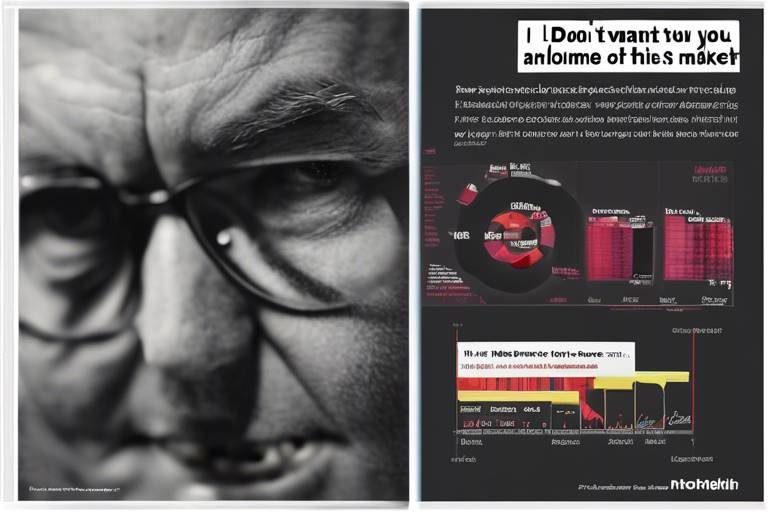Market Analysis - The Effect of Social Influencers on Crypto
The cryptocurrency market is a fascinating and ever-evolving landscape, driven not just by technology and economics but also by the voices of social influencers. These individuals, with their unique ability to sway opinions and behaviors, are shaping the way we perceive and interact with cryptocurrencies. It's not just about charts and algorithms anymore; it's about the narratives that influencers create and propagate across various platforms. In this article, we'll explore the profound impact that social influencers have on the cryptocurrency market, examining their role in trends, investment behaviors, and overall market sentiment. We'll also delve into the challenges and opportunities that arise from this dynamic relationship.
Social influencers are individuals who have established credibility and a significant following on social media platforms. They possess the power to shape opinions, drive trends, and influence purchasing decisions across various markets, including cryptocurrency. What makes these influencers effective is their ability to connect with their audience on a personal level, often sharing their own experiences and insights. This connection fosters trust, which is crucial in a market as volatile as cryptocurrency. Influencers utilize various mechanisms to exert their influence, such as engaging content, informative posts, and real-time updates that resonate with their followers.
With the meteoric rise of cryptocurrency, a new breed of influencers has emerged, specifically focused on this digital frontier. These crypto influencers have carved out a niche for themselves, leveraging platforms like Twitter, Instagram, and YouTube to build communities centered around cryptocurrency discussions. The growth of these influencers can be attributed to several factors, including the increasing accessibility of cryptocurrency information and the desire for more personalized insights in a complex market. As more people enter the crypto space, the role of these influencers becomes even more pronounced, as they guide new investors through the intricacies of trading and investing.
Different social media platforms serve as breeding grounds for crypto influencers, each offering unique advantages. Here are some of the most effective platforms:
- Twitter: Known for its fast-paced nature, Twitter allows influencers to share quick insights and updates, making it a favorite among crypto enthusiasts.
- Instagram: With its visual appeal, Instagram attracts a younger audience, where influencers use engaging graphics and videos to explain complex concepts.
- YouTube: Video content on YouTube allows for in-depth analysis and tutorials, helping followers understand the nuances of cryptocurrency trading.
Twitter has become a central hub for cryptocurrency discussions, with influencers using the platform to share insights, predictions, and updates. The real-time nature of tweets means that information spreads quickly, allowing influencers to shape market sentiment almost instantaneously. For instance, a tweet from a well-known influencer can lead to a surge in interest for a particular cryptocurrency, driving prices up within minutes. This phenomenon highlights the power of social media in influencing market behavior, as followers often react impulsively to the latest trends.
Instagram's visual nature attracts a unique audience to the world of cryptocurrency. Influencers on this platform utilize eye-catching graphics, infographics, and short videos to educate and engage their followers about crypto trends. The appeal of visually-driven content makes complex information more digestible, which is essential in a field that can be daunting for newcomers. By presenting information in an engaging format, these influencers not only inform but also inspire their followers to explore the world of cryptocurrency.
The influence of social media extends beyond just discussions; it significantly affects market trends, often driving price volatility. Influencers can create buzz around certain cryptocurrencies, leading to rapid price increases or decreases based on their recommendations. For example, when a popular influencer endorses a new token, it can lead to a rush of investments, pushing the price up dramatically. Conversely, negative sentiments shared by influencers can result in panic selling, causing prices to plummet.
The behaviors of investors are increasingly shaped by social media narratives. Retail investors often turn to influencers for guidance on when to buy or sell. This reliance on influencers can lead to herd behavior, where individuals follow the crowd rather than conducting their own research. While this can create opportunities for quick profits, it also exposes investors to risks, particularly if they are swayed by misinformation or hype without understanding the underlying asset. The psychology of investing in cryptocurrency is heavily influenced by social media, making it essential for investors to approach influencer advice with caution.
Real-world examples illustrate the tangible effects of influencer recommendations on cryptocurrency prices. One notable case involved an influencer tweeting about a lesser-known altcoin, which led to a massive influx of investments, causing the price to skyrocket within hours. Conversely, when another influencer expressed skepticism about the future of a popular token, it resulted in a significant drop in its value. These instances underscore the power that influencers wield in the market, as their words can lead to substantial financial consequences for investors.
While influencers can provide valuable insights, they also pose risks. One major challenge is the potential for misinformation. Not all influencers have the expertise or integrity to provide sound advice, leading to scenarios where followers make poor investment decisions based on misleading information. Additionally, the cryptocurrency market is notorious for its susceptibility to manipulation. Influencers might promote a token to inflate its price, only to sell off their holdings once the price rises, leaving their followers at a loss. Investors must navigate these risks carefully, ensuring they conduct their own research and not rely solely on influencer guidance.
As the cryptocurrency landscape evolves, so too will the role of social influencers. We can expect to see an increase in the number of influencers specializing in niche areas of cryptocurrency, such as decentralized finance (DeFi) or non-fungible tokens (NFTs). Additionally, platforms may develop new features that enhance the way influencers engage with their audience, fostering deeper connections and more informed discussions. The future of influencer marketing in crypto will likely be characterized by a blend of authenticity, education, and community-building, as influencers strive to create a more informed investor base.
- What is the role of social influencers in the cryptocurrency market? Social influencers shape opinions and behaviors, driving trends and affecting investment decisions through their platforms.
- How do social media platforms affect cryptocurrency investment? Different platforms provide unique methods for influencers to share insights, impacting market sentiment and investor behavior.
- What are the risks of following influencer advice? Risks include misinformation and potential market manipulation, making it crucial for investors to conduct their own research.
- How can I identify credible influencers in the crypto space? Look for influencers with a proven track record, transparent communication, and a commitment to educating their audience.

Understanding Social Influencers
Social influencers have become pivotal figures in the digital age, shaping opinions, behaviors, and trends across various markets, including the rapidly evolving world of cryptocurrency. But what exactly defines a social influencer? At their core, these individuals leverage their online presence to connect with audiences, often cultivating a sense of trust and authority. They can be anyone from a popular YouTuber sharing their latest crypto investments to a Twitter user with a passionate following discussing the latest market trends.
Influencers typically exhibit a few key characteristics that allow them to wield such power. Firstly, they possess a deep understanding of their niche, which in this case is cryptocurrency. This knowledge empowers them to create content that resonates with their audience, whether it be through insightful analysis, educational posts, or entertaining content. Secondly, they are adept at engaging with their followers, fostering communities that share common interests and values. This engagement is crucial as it builds a loyal audience that is more likely to act upon the influencer's recommendations.
The mechanisms through which influencers exert their influence are multifaceted. They utilize various social media platforms to disseminate information and engage with their followers. For instance, they might share market predictions, investment strategies, or even personal experiences with different cryptocurrencies. By doing so, they not only inform their audience but also inspire action—leading many to buy, sell, or hold specific assets based on the influencer’s insights.
In the cryptocurrency space, the influence of these figures can be likened to a double-edged sword. On one hand, they can democratize information, making complex topics more accessible to the average person. On the other hand, their opinions can lead to herd behavior, where followers make impulsive decisions based on the latest trending tweet or video. This phenomenon can create significant volatility in the market, as seen in various instances where a single tweet from a prominent influencer has caused prices to skyrocket or plummet.
To better understand the impact of social influencers, it's essential to recognize the various platforms they utilize. Each platform offers unique advantages that cater to different types of content and audiences. For example, Twitter is often used for real-time updates and discussions, while Instagram leverages visual storytelling to engage followers. The choice of platform can greatly affect how influencers communicate their messages and the subsequent reactions from their audience.
In conclusion, social influencers are not just voices in the crowd; they are powerful entities that can shape the cryptocurrency landscape. Their ability to connect, inform, and engage with their audience makes them a force to be reckoned with. As we delve deeper into the world of crypto influencers, we will uncover how their impact extends beyond mere opinions, influencing market trends and investment behaviors in profound ways.

The Rise of Crypto Influencers
The emergence of social media has revolutionized the way we communicate, share information, and even invest. In this vibrant digital landscape, crypto influencers have carved out a significant niche, capturing the attention of millions and shaping the cryptocurrency market like never before. These individuals, often armed with a deep understanding of blockchain technology and market dynamics, have transformed from mere enthusiasts to powerful voices that can sway investor sentiment and drive market trends.
So, what exactly sparked this rise? The answer lies in the unique blend of accessibility and engagement that social media platforms offer. Unlike traditional financial advisors, crypto influencers often share their insights in a more relatable and engaging manner. They break down complex concepts into digestible content, making cryptocurrency more approachable for the average person. This democratization of information has led to a surge in interest and investment in digital currencies, with influencers acting as guides through the often turbulent waters of the crypto world.
Platforms such as Twitter, Instagram, and YouTube have become the primary stages for these influencers, allowing them to build communities around shared interests. On Twitter, for instance, influencers can quickly disseminate information, engage in discussions, and respond to market changes in real-time. This immediacy creates a dynamic environment where followers feel connected and informed. As a result, many influencers have amassed substantial followings, making them key players in the cryptocurrency ecosystem.
Moreover, the rise of crypto influencers has led to the formation of various communities that rally around specific coins or investment strategies. These communities often share insights, tips, and experiences, fostering a sense of belonging among members. However, it’s important to note that not all influencers are created equal. Some offer genuine advice based on research and experience, while others may promote projects for personal gain, leading to potential risks for unsuspecting investors.
In addition to community building, influencers also leverage their platforms to promote educational content. This includes tutorials, market analyses, and even live Q&A sessions, all aimed at empowering their audience. Many followers appreciate this approach, as it not only keeps them informed but also helps them make more educated investment decisions. However, the line between education and promotion can sometimes blur, raising questions about the motives behind certain endorsements.
As we look to the future, it’s evident that the role of crypto influencers will only continue to grow. They have become integral to the cryptocurrency landscape, influencing everything from market trends to public perception. The key takeaway here is that while these influencers can provide valuable insights, investors must remain vigilant and do their own research before making any financial decisions.

Key Platforms for Crypto Influencers
In today's digital age, the rise of social media has transformed the way we communicate, share information, and influence each other. When it comes to cryptocurrency, certain platforms have emerged as key players in the influencer landscape. These platforms not only serve as a stage for influencers to showcase their insights and predictions but also foster a community of followers eager to learn and invest. So, which platforms are making waves in the crypto world?
One of the most significant platforms is Twitter. Often referred to as the "town square" of the internet, Twitter allows influencers to share real-time updates, engage in discussions, and respond to market changes almost instantaneously. The character limit encourages brevity, forcing influencers to convey their thoughts succinctly, which can lead to viral tweets that sway market sentiment. For instance, a single tweet from a well-known influencer can send a cryptocurrency's price soaring or plummeting within minutes, illustrating the power of this platform.
Instagram is another critical player, appealing to a visually-oriented audience. Influencers on Instagram utilize eye-catching graphics, infographics, and videos to break down complex crypto concepts into digestible content. This visual storytelling not only educates followers but also engages them emotionally, making the often-niche topic of cryptocurrency more relatable. With the rise of features like Stories and Reels, influencers can provide quick updates and insights, keeping their audience informed and entertained.
Additionally, YouTube has become a hub for in-depth analysis and tutorials. Influencers leverage the platform's video format to conduct live discussions, explain intricate blockchain concepts, or review the latest trends in the market. The ability to create longer content allows for a deeper dive into topics, which can be invaluable for both novice and seasoned investors. Influencers often build a loyal following on YouTube, as viewers appreciate the personal connection that comes from seeing a face behind the information.
Furthermore, Reddit has carved out a niche as a community-driven platform where cryptocurrency enthusiasts gather to discuss and share insights. Subreddits like r/CryptoCurrency and r/Bitcoin are filled with user-generated content, where influencers may not always be the traditional celebrities but rather knowledgeable individuals who have earned respect within the community. The democratic nature of Reddit allows for a diverse range of opinions, which can lead to robust discussions and collective decision-making among investors.
To summarize, the effectiveness of these platforms can be attributed to their unique characteristics:
| Platform | Strengths |
|---|---|
| Real-time updates, succinct communication, high engagement | |
| Visual storytelling, emotional engagement, quick updates | |
| YouTube | In-depth analysis, tutorials, personal connection |
| Community-driven discussions, diverse opinions, collective decision-making |
As these platforms continue to evolve, so too will the strategies employed by crypto influencers. Understanding which platforms resonate most with audiences can help investors navigate the often turbulent waters of the cryptocurrency market. Whether you’re following a tweet, watching a YouTube tutorial, or engaging in Reddit discussions, the influence of these platforms is undeniable and continues to shape the future of cryptocurrency investing.

Twitter's Role in Crypto Discourse
In the fast-paced world of cryptocurrency, Twitter has emerged as a pivotal platform for discourse, shaping opinions and driving market movements. With its real-time updates and vast reach, Twitter serves as a digital town square where enthusiasts, investors, and influencers converge to discuss trends, share insights, and speculate on future prices. This platform has become synonymous with crypto culture, where a single tweet can send ripples through the market, influencing everything from investment strategies to public sentiment.
What makes Twitter particularly effective in the realm of cryptocurrency? For starters, the platform's character limit encourages concise and impactful communication. Influencers often distill complex ideas into bite-sized tweets, making them easily digestible for a wide audience. Additionally, the use of hashtags, such as #Crypto, #Bitcoin, or #Altcoin, allows users to follow specific discussions and trends, creating a vibrant ecosystem of information exchange. This immediacy and accessibility foster a sense of community among crypto enthusiasts, who eagerly share their thoughts and analyses.
Moreover, Twitter is home to a variety of influencers, from seasoned traders to new entrants in the crypto space. These individuals utilize the platform to share their predictions, market analyses, and even personal experiences with different cryptocurrencies. Their engagement can significantly sway public opinion and investor behavior. For instance, when a well-known influencer tweets about a particular coin, the subsequent surge in interest can lead to dramatic price fluctuations, illustrating the profound impact these social media figures can have.
To further illustrate the dynamics of Twitter in crypto discourse, consider the following table that highlights key aspects of how influencers operate on the platform:
| Aspect | Description |
|---|---|
| Real-Time Updates | Influencers provide immediate insights on market movements, allowing followers to make quick decisions. |
| Engagement | Users can interact with influencers through retweets, likes, and comments, fostering community discussions. |
| Hashtags | Utilization of trending hashtags helps categorize discussions and makes information more accessible. |
| Influencer Credibility | Followers often base their investment decisions on the perceived credibility and track record of influencers. |
However, while Twitter can be a valuable source of information, it also has its pitfalls. The rapid spread of information can lead to misinformation, where unverified claims can create panic or hype around certain cryptocurrencies. This highlights the importance of critical thinking and due diligence among investors. As the crypto market continues to evolve, the role of Twitter as a platform for discourse will likely expand, making it essential for users to navigate this space with caution and insight.

Instagram and Visual Influence
In the vibrant world of cryptocurrency, Instagram has emerged as a powerful platform for influencers to connect with audiences through stunning visuals and engaging content. Unlike other platforms that rely heavily on text, Instagram thrives on imagery, making it an ideal space for influencers to showcase the dynamic and often complex nature of cryptocurrencies. Think about it: when you scroll through your feed, what catches your eye first? It's usually those eye-popping graphics or videos that tell a story at a glance.
Influencers on Instagram utilize a variety of visual strategies to capture the attention of their followers. They often share infographics that break down complicated crypto concepts into digestible bites, making it easier for their audience to understand the intricacies of blockchain technology or the latest market trends. Moreover, many influencers create short videos or Reels that provide quick updates on market movements or explain the basics of investing in cryptocurrencies. This visual storytelling not only educates but also entertains, fostering a deeper connection between the influencer and their audience.
Additionally, the use of Instagram Stories allows influencers to engage their followers in real-time, providing a more personal touch. They can share their thoughts on market shifts, respond to audience questions, or even conduct live Q&A sessions. This immediacy creates a sense of community and belonging among followers, who often feel they are part of an exclusive club of crypto enthusiasts. As a result, followers are more likely to act on the information shared, whether it's investing in a new coin or following a trading strategy suggested by their favorite influencer.
However, the visual nature of Instagram also presents challenges. The platform's emphasis on aesthetics can sometimes overshadow the importance of accurate information. Influencers may prioritize eye-catching content over factual accuracy, leading to the spread of misinformation. For instance, a flashy post about a new cryptocurrency could generate buzz without providing a thorough analysis of its fundamentals. This phenomenon underscores the need for followers to approach influencer content with a critical eye, balancing excitement with due diligence.
In conclusion, Instagram's visual influence in the cryptocurrency space is undeniable. It has transformed how information is shared and consumed, allowing influencers to reach and educate a broader audience. As more people turn to social media for investment advice, understanding the power of visual storytelling on platforms like Instagram becomes essential for both influencers and their followers.
- How do Instagram influencers impact cryptocurrency investments? Influencers often shape market sentiment and can lead to significant price movements through their recommendations and insights.
- What types of content do crypto influencers share on Instagram? They typically share infographics, market analysis videos, trading strategies, and personal insights related to cryptocurrency trends.
- Are all crypto influencers reliable sources of information? Not necessarily. It's crucial for followers to verify the information and consider the influencer's expertise and track record.
- How can I identify trustworthy crypto influencers on Instagram? Look for influencers with a solid background in finance or crypto, a transparent approach to sharing information, and a history of accurate predictions.

Impact on Market Trends
The influence of social media personalities on the cryptocurrency market is nothing short of revolutionary. In a world where information travels faster than a speeding bullet, social influencers have the power to sway market trends with a single tweet or post. Imagine a scenario where a well-known influencer shares a positive sentiment about a specific cryptocurrency; within moments, the price can skyrocket as thousands of investors rush to buy in. This phenomenon is not just a fluke; it's a trend that has been observed repeatedly in the crypto space.
One of the most striking examples of this influence occurred in 2021 when a single tweet from Elon Musk about Dogecoin sent its price soaring by over 800%. This is a classic case of how a social influencer can create a ripple effect in the market. The excitement generated by such endorsements can lead to a surge in demand, which in turn drives prices up. Conversely, negative comments or skepticism from influencers can lead to panic selling, causing prices to plummet. The volatility that ensues is a testament to the power of influencer marketing in the crypto realm.
Moreover, influencers often create a sense of community around specific cryptocurrencies, which can further amplify their impact on market trends. For instance, communities on platforms like Reddit and Telegram often rally around influencers who provide insights, predictions, or even memes related to certain coins. This collective enthusiasm can lead to coordinated buying efforts, which can significantly affect market prices.
To illustrate this further, consider the following table that summarizes key instances where influencer actions led to notable market movements:
| Date | Influencer | Cryptocurrency | Price Movement |
|---|---|---|---|
| April 2021 | Elon Musk | Dogecoin | +800% |
| May 2021 | Elon Musk | Bitcoin | -30% |
| July 2021 | Mark Cuban | Ethereum | +20% |
As you can see, the correlation between influencer activity and market price movements is striking. This dynamic creates a double-edged sword for investors. On one hand, the insights provided by influencers can lead to profitable opportunities; on the other hand, the same influencers can create panic or hype, leading to poor investment decisions.
In conclusion, the impact of social influencers on market trends is profound and multifaceted. They serve as both catalysts for price movements and as leaders of community sentiment. As the cryptocurrency market continues to evolve, understanding the relationship between social influencers and market trends will be crucial for investors looking to navigate this volatile landscape effectively.
- How do social influencers affect cryptocurrency prices? Social influencers can sway public opinion and create demand for specific cryptocurrencies, leading to significant price fluctuations.
- Are all influencer recommendations reliable? Not necessarily. While some influencers provide valuable insights, others may promote coins for personal gain, leading to misinformation.
- What should investors consider when following influencers? Investors should conduct their own research and not rely solely on influencer opinions to make investment decisions.

Investment Behaviors Influenced by Social Media
The world of cryptocurrency is not just about numbers and charts; it's a vibrant tapestry woven with the threads of social media influence. As more people turn to platforms like Twitter, Instagram, and TikTok for investment advice, the behaviors of retail investors are increasingly shaped by the narratives spun by social influencers. Have you ever wondered how a single tweet can send a coin's value soaring or crashing? This phenomenon is a testament to the power of social media in the crypto space.
Social media has transformed the way investors perceive and engage with the cryptocurrency market. With just a few clicks, influencers can share their insights, predictions, and even memes that resonate with thousands of followers. This immediacy creates a sense of urgency among investors, often leading them to make hasty buying or selling decisions based on trending topics or viral posts. For instance, when a well-known influencer tweets about a new coin, it can trigger a buying frenzy, pushing the price up rapidly. Conversely, negative comments can lead to panic selling, illustrating the volatility that social media can introduce.
Moreover, the sense of community fostered by these platforms plays a significant role in shaping investment behaviors. Investors often seek validation from their peers, and when influencers endorse a particular asset, it can create a bandwagon effect. This is especially prevalent in the crypto community, where discussions about "the next big thing" can lead to collective buying behaviors. Investors may feel compelled to follow the crowd, driven by fear of missing out (FOMO) or the desire to be part of the latest trend.
To better understand this dynamic, consider the following factors that illustrate how social media influences investment behaviors:
- Peer Influence: Investors are likely to follow the recommendations of influencers they trust, often leading to herd behavior.
- Information Overload: The sheer volume of content can overwhelm investors, making it challenging to discern valuable insights from noise.
- Emotional Trading: Social media can amplify emotions, causing investors to act impulsively rather than based on sound analysis.
As we delve deeper into this subject, it's essential to recognize the potential risks associated with following influencer advice. While some influencers offer genuine insights, others may lack the expertise or may even have ulterior motives, such as promoting a coin they own to inflate its price. This raises questions about the integrity of information circulating on social media and its implications for investors.
In conclusion, social media is reshaping the landscape of cryptocurrency investment behaviors. The blend of community engagement, rapid information dissemination, and emotional responses creates a unique environment where decisions are often made in the heat of the moment. As an investor, it's crucial to approach social media with a critical eye, balancing influencer insights with thorough research and analysis. After all, in the fast-paced world of crypto, the best investment strategy is often one that combines knowledge with caution.
Q1: How can I differentiate between credible and non-credible influencers?
A1: Look for influencers with a proven track record, transparency about their investments, and those who provide well-researched content rather than just hype.
Q2: Should I always follow influencer advice?
A2: No, it's essential to conduct your own research and consider multiple viewpoints before making investment decisions.
Q3: What are the risks of following social media trends in crypto?
A3: Risks include misinformation, market manipulation, and emotional trading, which can lead to significant financial losses.

Case Studies of Influencer Impact
When it comes to the cryptocurrency market, the influence of social media personalities can be both astonishing and alarming. One of the most striking examples is the case of Elon Musk. His tweets about Bitcoin and Dogecoin have not only captured the attention of millions but have also led to immediate and significant price fluctuations. For instance, when Musk tweeted that he was "working with Dogecoin developers to improve system transaction efficiency," the price of Dogecoin skyrocketed by over 20% within hours. This incident showcases how a single tweet from a prominent figure can create a ripple effect throughout the market, turning casual investors into fervent traders.
Another noteworthy example involves the YouTube influencer known as "BitBoy Crypto." With a massive following, BitBoy has been instrumental in shaping the opinions of retail investors. In a video where he predicted a bullish trend for Ethereum, the price surged shortly after. His followers, motivated by his confidence and the community he has built, often rush to invest based on his recommendations. This phenomenon highlights the power of community and trust that influencers build with their audience, often leading them to make significant financial decisions based on the influencers' insights.
However, not all influencer-driven market movements are positive. The infamous "Pump and Dump" schemes often utilize social media to manipulate prices. In one case, a group of influencers coordinated to promote a lesser-known altcoin, leading to a sharp increase in its price. Once the price peaked, the influencers sold off their holdings, causing the price to plummet and leaving many retail investors with significant losses. This scenario underscores the darker side of influencer impact, where the lack of regulation in the cryptocurrency market can lead to exploitation.
To provide a clearer picture, here’s a table summarizing some key case studies of influencer impact:
| Influencer | Action | Market Reaction | Outcome |
|---|---|---|---|
| Elon Musk | Tweeted about Dogecoin | Price surged by 20% | Increased interest in Dogecoin |
| BitBoy Crypto | Predicted Ethereum bullish trend | Price increased significantly | Heightened retail investor activity |
| Anonymous Influencers | Coordinated Pump and Dump | Price spiked then crashed | Losses for unsuspecting investors |
These case studies not only illustrate the tangible effects of influencer recommendations on cryptocurrency prices but also highlight the complexities of influencer marketing in this volatile space. As the cryptocurrency market continues to evolve, the influence of these personalities will likely grow, making it imperative for investors to remain vigilant and informed.
- What is the role of social influencers in the cryptocurrency market? Social influencers can significantly impact market sentiment, trends, and investment behaviors, often leading to rapid price changes.
- How can I identify trustworthy influencers? Look for influencers with a track record of transparency, accurate predictions, and a genuine understanding of the cryptocurrency market.
- Are all influencer recommendations reliable? No, not all recommendations are reliable. It's essential to conduct your own research before making investment decisions based on influencer advice.
- What are the risks associated with following influencers? Risks include misinformation, market manipulation, and potential financial losses, especially in cases of pump and dump schemes.

Risks and Challenges of Influencer Guidance
While social influencers can provide valuable insights and guidance in the cryptocurrency space, relying on them for investment decisions comes with its own set of risks and challenges. The cryptocurrency market is notoriously volatile, and the opinions of influencers can sway public sentiment almost overnight. This means that what may seem like a solid recommendation today could lead to significant losses tomorrow. But what exactly are these risks?
One of the primary challenges is the potential for misinformation. Influencers, while knowledgeable, are not always experts. They may share opinions based on personal beliefs or unverified information, which can mislead their followers. For example, a popular influencer might tweet about a new altcoin, causing a rush of investors to buy in without proper research. This can inflate the coin's price temporarily, but if the underlying project lacks substance, it may crash, leaving many investors at a loss.
Another significant risk is market manipulation. Some influencers may have financial incentives to promote certain cryptocurrencies, either through partnerships or personal holdings. This creates a conflict of interest, as their recommendations might not be in the best interest of their followers. For instance, if an influencer holds a large amount of a specific coin, they could pump its price by promoting it, only to sell off their holdings once the price rises, leaving their followers to deal with the fallout.
Additionally, the emotional aspect of investing can amplify these challenges. Many retail investors tend to follow influencers out of a desire for community and belonging. This herd mentality can lead to impulsive decisions, where followers buy or sell based on the latest influencer hype rather than sound financial principles. It’s essential for investors to remember that just because someone has a large following doesn’t mean their advice is trustworthy.
To navigate these risks, investors should take a proactive approach:
- Conduct thorough research: Always verify the information shared by influencers. Look for multiple sources and data before making any investment decisions.
- Diversify investments: Don’t put all your eggs in one basket. Spread your investments across various assets to mitigate risks.
- Stay informed: Keep up with market trends and news from reputable sources, rather than solely relying on social media.
In conclusion, while influencers can be a source of valuable information in the cryptocurrency market, it’s crucial for investors to approach their guidance with caution. By understanding the risks and challenges, and implementing strategies to mitigate them, investors can make more informed decisions and potentially avoid costly mistakes.
Q: How can I tell if an influencer is trustworthy?
A: Look for influencers who provide transparent information, have a consistent track record of accurate predictions, and disclose any potential conflicts of interest.
Q: Is it safe to follow influencer recommendations?
A: While some recommendations can be valuable, it's essential to conduct your own research and not rely solely on influencer advice.
Q: What should I do if I lose money after following an influencer's advice?
A: It's important to assess the situation, learn from the experience, and avoid making impulsive decisions in the future. Consider diversifying your investments and seeking advice from financial professionals.

Future Trends in Influencer Marketing
As we look ahead, the landscape of influencer marketing in the cryptocurrency sector is poised for significant transformation. The rapid evolution of technology and the increasing integration of social media into our daily lives are driving these changes. Influencers will likely evolve from mere promoters to trusted advisors, as their followers seek more than just flashy endorsements; they want authentic, reliable insights. This shift will challenge influencers to cultivate deeper relationships with their audiences, ensuring that the information they provide is not only engaging but also educational.
One of the most exciting trends on the horizon is the rise of micro-influencers in the cryptocurrency space. Unlike their more prominent counterparts, micro-influencers often boast smaller, yet highly engaged, audiences. This engagement can lead to more meaningful interactions and a higher level of trust among followers. In fact, studies show that consumers are more likely to act on recommendations from micro-influencers than from larger influencers due to their perceived authenticity and relatability.
Moreover, we can expect to see an increase in the use of video content across various platforms. Short-form videos, such as those found on TikTok or Instagram Reels, are becoming increasingly popular, especially among younger audiences. Influencers will harness this trend to simplify complex cryptocurrency concepts through engaging visual storytelling. Imagine a quick, snappy video that breaks down the intricacies of blockchain technology or explains the latest trends in meme coins. This approach not only captures attention but also enhances understanding.
In addition, the integration of Augmented Reality (AR) and Virtual Reality (VR) into influencer marketing is on the rise. Influencers may soon host immersive experiences that allow followers to explore virtual cryptocurrency markets or participate in simulated trading environments. This innovative approach will not only provide education but also create a sense of community among followers, as they can engage with each other in these virtual spaces.
Another trend to watch is the growing emphasis on transparency and accountability. As regulatory scrutiny increases in the cryptocurrency market, influencers will need to disclose their affiliations and sponsorships more rigorously. This will foster a culture of honesty and integrity, which is essential for maintaining trust among followers. Influencers who prioritize transparency will likely stand out in a crowded market, attracting audiences who value authenticity and ethical practices.
Finally, the future of influencer marketing in crypto will likely see a shift towards collaborative content creation. Influencers may partner with financial experts, analysts, and even blockchain developers to produce content that is not only entertaining but also informative and insightful. This collaboration can lead to richer content that addresses the diverse needs of the audience and provides a more rounded perspective on the ever-changing crypto landscape.
- What role do social influencers play in the cryptocurrency market?
Social influencers shape opinions and behaviors, often driving trends and investment decisions among retail investors. - How can I identify credible crypto influencers?
Look for influencers who provide transparent information, engage with their audience, and have a track record of accurate predictions. - What are the risks of following crypto influencers?
Influencers can sometimes spread misinformation or promote pump-and-dump schemes, so it's essential to conduct your own research. - Will micro-influencers be more effective than larger influencers?
Yes, micro-influencers often have more engaged audiences and can build stronger connections with their followers.
Frequently Asked Questions
- What are social influencers in the cryptocurrency market?
Social influencers in the cryptocurrency market are individuals or entities that have the power to affect the opinions and behaviors of others regarding crypto investments. They often leverage platforms like Twitter, Instagram, and YouTube to share insights, predictions, and updates, thereby shaping market sentiment.
- How do social media platforms impact cryptocurrency trends?
Social media platforms serve as vital channels for the dissemination of information and opinions about cryptocurrencies. They allow influencers to reach a large audience quickly, making it easier for them to drive trends and influence market movements. For example, Twitter is often used for real-time updates, while Instagram provides a visual approach to engaging followers.
- Can following influencers lead to poor investment decisions?
Yes, following influencers can sometimes lead to poor investment decisions. While many influencers provide valuable insights, there is also a risk of misinformation and market manipulation. Investors should be cautious and conduct their own research before making decisions based solely on influencer recommendations.
- What are some examples of influencer impact on cryptocurrency prices?
There have been several notable instances where influencer actions have led to significant price movements in the cryptocurrency market. For example, a single tweet from a prominent influencer can cause a rapid increase or decrease in a cryptocurrency's value, demonstrating the power that influencers hold over retail investors.
- What challenges do investors face when listening to influencers?
Investors face several challenges when relying on influencers, including the potential for misinformation, lack of accountability, and the influence of personal biases. Additionally, some influencers may promote projects for their own financial gain, which can mislead their followers.
- How is the role of influencers expected to evolve in the future?
As the cryptocurrency landscape continues to evolve, the role of influencers is likely to grow even more significant. They may adopt new strategies and platforms to engage their audiences, and their influence could extend into more complex areas like decentralized finance (DeFi) and non-fungible tokens (NFTs).



















